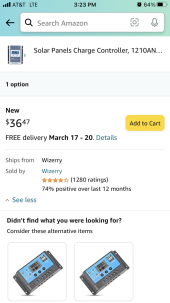taiyoken
New Member
- Joined
- Sep 3, 2022
- Messages
- 12
Hi there, I’m wondering how I can keep my 12v flooded starter battery charged. I have a 24v lithium system for my camper van, and I’d like to top off the starter when I have capacity (or am charging, such as via shore power or solar). My first thought was to use a Victron Orion 24/12 charger (I use a 12/24 to charge my house battery via my alternator), but I’m imagining there has to be a cheaper way. I’ve seen small MPPT solar panel maintainers for around $80 and I’ve used my AC battery maintainer (which was around that much), so something about dropping $200 on the Victron makes me think I might be overthinking it. Does anyone have a recommendation for how to approach this problem?
On another note… if I were to splurge for the Victron, I’d love to power my 12V appliances as well (I currently have a cheap UXCELL converter), but in my mind it’s one or the other— charging the starter or powering my 12v appliances. That said, am I overthinking that as well?
On another note… if I were to splurge for the Victron, I’d love to power my 12V appliances as well (I currently have a cheap UXCELL converter), but in my mind it’s one or the other— charging the starter or powering my 12v appliances. That said, am I overthinking that as well?




_IMG_4225.HEIC?width=960&height=720&fit=bounds)